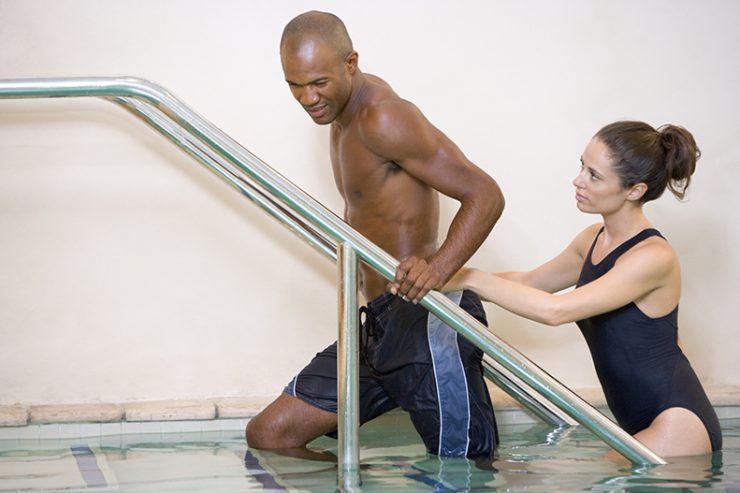Simply put, aquatic physical therapy is the practice of physical therapy in the water. An aquatic program is designed by a patient’s physical therapist as part of an individualized treatment plan to achieve specific goals. The pools used are designed specifically for physical therapy and are often smaller and have adaptations (like handrails) to enhance patient comfort and accessibility.
Benefits of Aquatic Physical Therapy
Aquatic therapy can be beneficial for a number of different patients and is not utilized for specific diagnoses, but instead is used to address particular problems a patient may have including:
- Balance and coordination
- Muscle strengthening
- Function/mobility
- Increasing flexibility
One of the reasons aquatic therapy can be beneficial to patients is because the water absorbs most of the pressure our body weight typically puts onto our joints. By conducting physical therapy in the water, the body becomes more buoyant and decreases the amount of stress on your joints.
Aquatic therapy is typically used for patients who:
- Are not allowed full weight bearing but need to work on walking
- Need to work on jumping or landing but are unable to tolerate high impact activities
- Are recovering from surgery
- Are experiencing acute low back pain and cannot tolerate standing and walking
- Are athletes and need to break down sport specific drills in a more controlled environment
Physical therapists at UPMC Sports Medicine have been utilizing aquatic therapy with patients for the past 15 years, and therapists at the new UPMC Lemieux Sports Complex will also incorporate aquatic therapy into treatment. The new complex will have the ability to assess patients with an under water camera and monitor which will provide feedback on their performance.
Aquatic Therapy for Athletes
Recognizing the other potential benefits of aquatic therapy on strength and conditioning, the experts at the new UPMC Lemieux Sports Complex have begun incorporating it into recommendations for strength training plans. Water workouts allow healthy athletes to undergo a higher intensity workout while reducing the risks of injury and post-workout soreness.
Pat Garvey, DPT, the facility director of the UPMC Lemieux Sports Complex says, “Strength coaches favor water workouts because the impact to the athlete’s body is decreased so much that they are able to perform intense workouts multiple days in a row. Water is more resistant than air, so a water workout for 30 minutes has the potential to be as effective as a two-hour, intense dry land workout.”
Initially many people doubt the benefits of a water workout because they picture horsing around and goofing off in the pool. However, water workouts are far from easy. Take for example the below workout:
Warm-up
Jump in the pool and get your body moving. Anything you can do to get your heart rate up will work. We suggest walking or swimming a few laps if your pool is large enough. If your pool is smaller try jumping jacks or mountain climbers.
The next portion of your workout will depend on your specific goals.
For speed, try interval running
- 15-second runs at 90% effort
- 5-second sprints at 100% effort
- 18 second high knees at 100% effort
For strengthening and agility try
- Forward kicks
- Side kicks
- Lunges
- Squat jumps
With the right preparation, almost any dry land exercise can be adapted for your water workout. There are a number of plans available online, but we recommend reaching out to your athletic trainer, physical therapist, or other expert before starting one.
For more information on aquatic therapy, contact UPMC Sports Medicine at 1-855-93-SPORT (77678).
